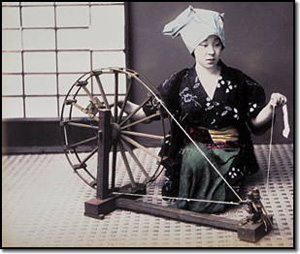What's Out There: Make Do and Mend – Japanese Style
Boro is based on the Japanese value of “mottainai” or “too good to waste.” Boro is also the name for the clothing that was worn by peasants, merchants or artisans in Japan from Edo up to early Showa (17th–early 19th century). In feudal times, the majority of Japanese people were peasant farmers. They could not afford, nor were they allowed to wear, the lavish silk kimono and vivid obi worn by the aristocracy. Clothes were crafted from cheaper materials, but were no less beautiful than those worn by the upper classes.
Cotton was scarce in Japan until the 20th century, but hemp was abundant. Hemp, and later cotton as well, was homespun by rural women, dyed with indigo and woven into beautiful patterns. Cotton, imported from China, could be woven through the hemp fabrics to make it warmer. Even later, when cotton was more widely produced in Japan, rural workers were too poor to purchase cloth of the cotton they grew and spun.

Boro can also be translated as rags or scraps of cloth, and is used to describe clothes and other household items which have been patched-up and repaired many times. Once clothing was made, it would be maintained throughout the owner’s lifetime, or perhaps even longer. For peasant families, each garment would last long enough to be passed down through generations. Daily use would require frequent repair. This is a farm woman’s jacket from the early 1900s. I’m sure she would be amazed to find out that it’s for sale for $650.

Now, boro textiles are usually sewn from nineteenth and early twentieth century rags and patches of indigo dyed cotton. The diversity of patches on any given piece is a veritable encyclopedia of hand loomed cotton indigo from old Japan. Fabrics were sewn together with dense stitching of thick thread. Simple at first, the running stitches eventually became decorative, and sashiko embroidery was born.
Much like our patchwork quilts, boro can also show the story of a family, with old un-repairable garments being used to patch newer ones, or be pieced together and used as futon coverings for warmth. The pieces and fabric patterns would be recognizable by the family members, and others in the village as each woman developed her own weaving patterns. This is a detail of a futon cover.

The futon covers remind me very much of the Gees Bend quilts. Pieced with whatever is at hand, out of necessity, to keep the family warm. They are a beautiful example of care, and the value of making common objects beautiful.
You can see the making of the exhibit “Boro: The Fabric of Life” exhibited at Domaine de Boisbuchet. View photos from the exhibit here.
More information about Japanese textiles, and the Japanese textile industry can be found at kimonoboy.com. Also view vintage garments in detail. They are available for purchase; the prices are not for the faint of heart!
Less expensive boro textiles can be found on Ebay and Etsy using the search terms “Boro” or “Japanese folk textiles.”
It’s great to see increased interest in these old textiles and the ideas behind them, given the 20th and 21st century consumer attitude of wear a few times and toss.
Happy sewing!
Leigh Wheeler
President

